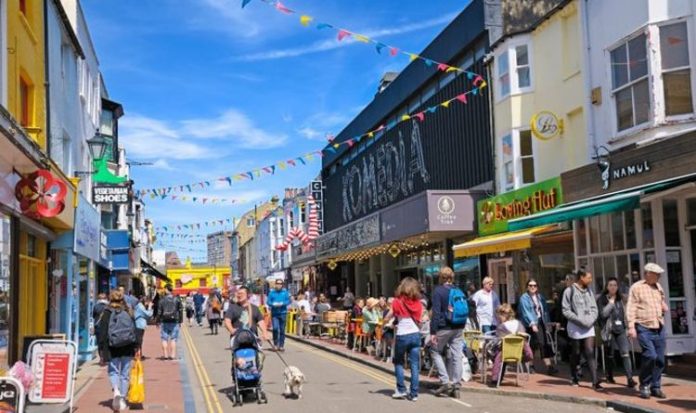City analysts said the two sets of data showed business was now back on track thanks to the further easing of lockdown restrictions.
While companies are still shedding jobs as a result of the coronavirus outbreak, green shoots are also starting to show, experts said.
The news on growth came from new figures set out in the IHS Markit/CIPS Flash UK composite purchasing managers’ index.
A closely watched measure in the City, the figures show it hit 60.3 in August, from a reading of 57.1 in July. Anything above 50 is considered growth. At the same time, there was equally good news from the high street as retail sales bounced back to pre-pandemic levels for the first time.
Buoyant analysts said the readings represented the fastest growth in private sector output since October 2013, surpassing market expectations of 56.7.
Tim Moore, economics director at IHS Markit, said: “The combined expansion of UK private sector output was the fastest for almost seven years, following sharp improvements in business and consumer spending from the lows seen in April.
“There were encouraging signs that customer-facing service providers have started to catch up with the rebound seen earlier this summer across the wider economy, with easing lockdown measures, staycations and the Eat Out To Help Out scheme all reported as factors supporting growth in August.”
The accelerated growth has been driven by improvements in the manufacturing and service sectors since July, the analysis said.
Higher levels of private sector output were largely attributed to the reopening of large parts of the economy in July and August, resulting in a jump in business and consumer spending.
Total volumes of new work expanded for the second month running, with the latest increase the fastest since July 2014, it was said.
However, the figures also revealed that concerns about the speed and duration of the recovery resulted in sustained job cuts across the private sector.
While job losses continued to be felt, this was driven by ongoing redundancy programmes as firms sought to reduce overheads before the end of the furlough programme.
Duncan Brock, group director at the Chartered Institute of Procurement and Supply, said: “With the fastest rise in activity in the private sector since October 2013, this shows an encouraging speed towards recovery which belies the fact there are still some dark forces at play.
“Rising inflation, the sustainability of the UK economy during a global pandemic and the poor employment figures mean we’re not out of the woods yet.”
But retailers were also buoyed by the news that shoppers are having the confidence to flood back to the high street. The Office for National Statistics figures showed that retail sales rose above pre-lockdown levels in July as a rebound in demand continued.
As shoppers’ confidence grew, retail sales volumes rose by 3.6 percent between June and July. The ONS said sales are now three percent higher than in February.
Ruth Gregory, senior economist at Capital Economics, said this suggested that “the recovery in physical shops was more impressive than the headline figure – shoppers are starting to return to the high street”.
But Helen Dickinson, chief executive of the British Retail Consortium, urged caution.
She said: “The latest ONS sales results mask a crisis under way in some parts of the retail industry.
“While food and online have shown growth, the hustle and bustle of shoppers and workers has yet to return to major town and city centres, continuing to impact sales in those locations. In-store non-food sales were down over £1.6billion per week during lockdown and July’s uplift reported by the ONS doesn’t make up for that lost ground.
“The survival of many retail businesses hangs in the balance. Some retailers haven’t been able to pay their rent for the period where they were required to close for our benefit and numbers of job losses and shop closures are rising.
“Unless another viable solution is found, the Government should extend the moratorium on aggressive landlord debt enforcement beyond September.”
The figures showed that clothing sales grew last month and people also spent more money on petrol.
July’s rise was not as pronounced as the previous two months. In May, retail sales had increased by 12 percent and in June they had risen by 13.9 percent.
Sales in clothing shops increased by 11.9 percent last month while online shopping fell by seven percent. However, the ONS findings said clothing shops had been “the worst hit during the pandemic” and that the volume of sales remained 25.7 percent lower than in February.
While fuel sales rose by 26.2 percent between June and July, they remain far below pre-pandemic levels, down 11.7 percent compared with February.
Analysts were cautious about a possible second wave of Covid-19. Emma-Lou Montgomery, associate director at Fidelity International, said that while “the outlook could feel a little brighter for retailers”, the pandemic was “far from over”.
She added: “With the UK now in a recession and many households likely to be tightening their belts as a result, spending on nonessential items may take a hit in the coming months, particularly as we approach the end of the furlough scheme in October.”
The UK had recorded its first recession since the financial crisis when the economy shrank by a record 20.4 percent between April and June.
A recession is defined at two consecutive quarters of shrinking gross domestic product. GDP fell by 2.2 percent in the first three months of this year.







